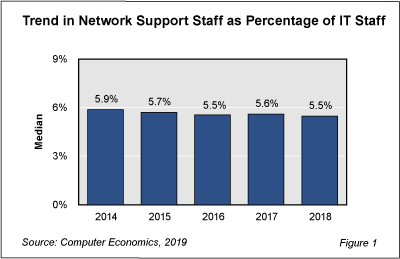The importance of computer networks cannot be overstated in this digital age. Yet remarkably, network support staff levels dropped in recent years and show no signs of rebounding. The increasing need for bandwidth, security, analytics, and reliability has not driven up the ratio of network support staff to total IT staff in the typical organization. Rather, as with other infrastructure support functions, the data suggests that easier-to-support technology and automation are enabling IT organizations to do more with fewer people.
As shown in Figure 1 from our full report, Network Support Staffing Ratios, network support staffing as a percentage of the total IT headcount has been essentially flat, ranging from 5.6% to 5.5% since 2016, with the 2018 rate settling at 5.5%. Network staffing is not going through as sharp a decline as some support positions, but neither are IT organizations adding a lot of network support personnel to make up for increased demands.

The network demands on IT organizations have been steadily increasing, with software as a service (SaaS), public cloud infrastructure, video conferencing, Internet of Things, real-time big data analytics, and other network-heavy technology. It appears that IT organizations have simply been able to support larger, faster, and more complex networks without major increases in staff. Automation, virtualization, software-defined networks, and improved best practices are making network support professionals more productive.
“While technologies such as SaaS, virtualization, and the cloud make it easier for companies to decrease the support burden of many of their systems, these same technologies add to the demands of the network,” said David Wagner, vice president of research at Computer Economics, an IT analyst firm based in Irvine., Calif. “Automation and software-defined networks are allowing network support staff to support larger, more complex networks, but it is unlikely this balance will last forever. As the digital transformation continues, we might see a rebound in this position, or automation may allow IT organizations to decrease staff as they have at other support positions. It is important to track this role going forward.”
In this study, network support staff includes personnel with titles of network engineer, architect, administrator, technician, specialist, or analyst for voice and data networks. The network support staff headcount does not include managers, but encompasses supervisors and senior-level personnel.
The full report will help IT managers determine whether their organization is keeping pace with improvements in network management by comparing their network support staffing ratios against industry benchmarks. We provide four benchmarks: network support staff as a percentage of the IT staff, network support staff as a percentage of the Network and Communications Group, users per network support staff member, and network devices per network support staff member. We provide benchmarks for the composite sample and by sector and organization size. We conclude with recommendations for reducing or at least maintaining the cost of network support staff.
This Research Byte is a brief overview of our report on this subject, Network Support Staffing Ratios. The full report is available at no charge for Computer Economics clients, or it may be purchased by non-clients directly from our website (click for pricing).
Do you also need staffing ratios for other IT job functions? Consider this collection of all of our staffing ratio reports, which bundles them all into a single report at a significant discount: IT Staffing Ratios–Special Report Bundle

